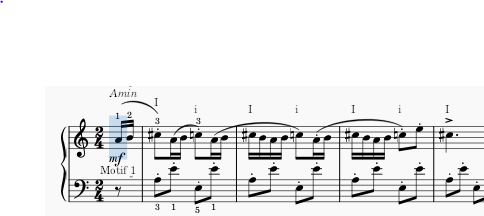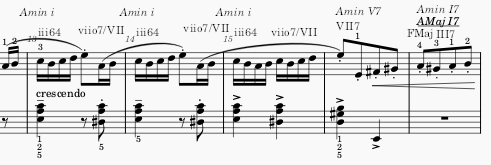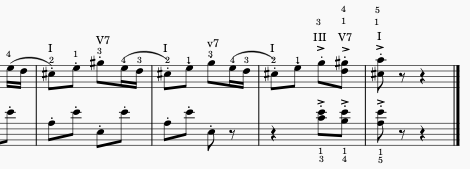Modulation gives the composer the means to smoothly – or abruptly – transition to a new key and change the feel of a piece and provides variety in larger forms such as sonatas and concertos. This technique is commonly associated with drama and suspense, among other feelings.
Modulation, similar to tonicization, changes the key of a piece of music with an accidental(s) or a key signature change. However, while tonicization returns to the original key, modulation is a bit more permanent. Think stick-on tattoos vs. ink tattoos.
Modulation comes in three main flavors:
- Pivot Chord Modulation
- Direct Modulation
- Closely Relate Keys
Music Matters’ Gareth Green explains the ins and outs of modulation and breaks down how and why it is used.
In this video, Green expounds on his explanation and shows how the circle of fifths is used to efficiently and effectively work out modulations.
This 5-minute video from Woochia shows how to smoothly modulate using various techniques.
Rick Beato explains modulation and demonstrates various ways to achieve the different types of modulation.
Pivot-Chord Modulation
Pivot-Chord modulation is employed when the starting key and the target keys share one or more chords that are diatonic and have the same quality in both keys.
The composer or arranger can use one of those chords to transition from the original key to the target key. There are options when using pivot chords depending on what kind of scale you are using and the effects that you want to deliver to the listener.


If you are familiar with basketball you know that once you stop and hold the basketball with both hands you can only pivot on one foot; the space you can move to is restricted by the foot that is planted. Same concept here basically – when using the pivot-chord technique, the music can only modulate to one of the keys with a shared chord. The Pivot-Chord technique is also called ‘common’ chord modulation.
Direct Modulation
Sometimes the music calls for a sudden change to show shock or surprise, or to get the listener’s attention. In this case, we would use direct modulation and directly switch to a new key without the use of a pivot chord.
Direct modulations do not usually have a close relationship with the original key. This type of modulation is also known as phrase modulation or abrupt modulation because of the sudden nature of the technique.
Closely Related Keys
The name seems self-explanatory, but there are some rules to follow when thinking about closely related keys.
Modulation in Practice
This week we are tasked with analyzing a piece of music that has modulation and showing where the modulation occurs.
The piece I chose was Clowns by Dimitry Kabalevsky. It features smaller modulations between A Major and A minor as a motif and modulates to F Major. The piece modulates between F Major and F minor before returning to the original key once more to close with a Perfect Authentic Cadence.
Clowns Score
Clowns-AnalysisAnalysis of Clowns – Dimitry Kabalevsky
Dimitry Kabalevsky’s Clowns is a short Grade 3 piece in common time that is fun to play; the piece makes one think of a jack-in-the-box being wound up. The piece is 25 bars in ternary form and proves to be a technical challenge, yet it is within the reach of a beginner or an older learner. The recurring motifs feature many patterns and finger positions that serve to familiarize the student with the basics of good technique in a less rigid form than more technical exercises.
Melodic Structure
The melody uses stepwise conjunct motion in the right hand for the majority of the song, but Kabalevsky alternates the smooth melody in the right hand with disjointed arpeggiated patterns that appear near the end of phrases.
Kabalevsky assigns a disjointed arpeggiated pattern to the left hand throughout the song except for the middle section where accented chords are played to accompany the melody in the modulated section. These chords seem to add to the tension of the piece that is also expressed through the movement to the closely related minor key.
In addition to the new tonal center, a constant upward battle is portrayed by the ascending motion in the melody in bars 13 through 17. The line seems to express a person climbing up a hill and being pulled back down until finally in bar 17 they are able to slowly grasp their footing and make big steps to free themselves from whatever force had been pulling them back from E to A.
In bars 22 through 25 we reach the highest notes we have seen throughout the song and Kabalevsky ends each stepwise descent with a big triadic skipping motion. First, he lands on G#, then he misses the mark and lands on G natural. Finally, he gets back to the G# and ends the piece with a stepwise motion in the soprano part to land on the Tonic with a Perfect Authentic Cadence from the dominant7 to the tonic.
Harmonic Structure
Kabalevsky is known for quickly alternating between major and minor harmonies. This technical device is found in all levels of his compositions and it is a dominating feature in Clowns. The piece modulates between parallel keys A minor and A Major in bars 1 through 8. Kabalevsky then modulates to the key of F minor in bar 9 and remains there until bar 13.
In bars 13 through 17, Kabalevsky modulates between the keys of F minor and F Major before using Secondary Leading-tone dominants to arrive at the common chord of E Major which can be found in A Major, A melodic minor, and F melodic minor. Kabalevsky also plays with the shared sounds of the C Major, D minor, and F major chords which are common to the keys mentioned above.
In section B, Kabalevsky uses the A minor chord to transition smoothly between A min and F Major. In sections B and D, Kabalevsky uses a chromatic passage that cycles through the related keys to arrive firmly at the original tonic, A natural.
Kabalevsky restates the original motif in bar 18, but this time the consequent is much different. Kabalevsky demonstrates sound technical knowledge of the manipulation of common tones to facilitate his modulations and to return to the original motif and eventually end the song.
Modulation as a Motivic Device and More
:format(webp):no_upscale()/cdn.vox-cdn.com/uploads/chorus_asset/file/11704435/whysoserious.jpg)
The rapid alternation of major and minor paints the typical picture of the sad and happy clown.
The tonality of the song changes from major to minor every 2 beats in bars 1 through 12 and bars 18 through 25, but the definite modulation takes place in bars 9 through 12.
Motifs






Phrasing, Dynamics, and Meaning
In addition to the tonality, the phrasing adds a lot to the character of the piece. The staccato in the left hand may represent the jovial nature of some clowns, whereas the joined phrases in the right hand may lean towards the more serious nature of some clowns.
Furthermore, the ever-changing nature of the piece may relate to the hidden identity of a clown. A person’s true identity is hidden under the layers of paint and accessories, and their emotions are cast to the side as they go into character.
Sections B1 and C introduce a strong sense of tension that is resolved with what seems to be an Inauthentic Perfect Cadence. The tension reappears at the close in Section F – bars 22 to 25, but the Perfect Authentic Cadence brings the ride to a close.
Conclusion
Despite the simple and fun nature of Kabalevsky’s piece, there are many lessons to learn from his approach in creating this exercise. He uses many advanced techniques but does so in such a way that the beginner is not hindered yet picks up good habits effortlessly. Though Kabalevsky did not rise to prominence as other composers did, his work in teaching and advancing music education shine through in pieces such as Clowns.
Music is subjective, and this piece definitely leaves room for many different interpretations. Regardless of how you view Clowns, this piece is much more serious than it seems.
Analysis of Coronation by Timothy Johnson
Coronation Score (2 pages)
CoronationScoreIntroduction
Coronation was composed by Timothy Johnson and is a concert study rather than a song and is unaccompanied. The piece is in ternary form and has three main sections that modulate from F Major to F minor and back to F Major. The piece is a bit more technical because of the many leaps and triads with varied phrase marks, dynamics, and accents. It is a challenging piece, but it is well worth the effort to learn.
As the name implies the piece sounds like it is fit for a Coronation, but there is an element of sorrow and action in the middle section. There seems to be some type of struggle in the kingdom despite the important coronation ceremony.
The first section is marked 90 BPM on the original score and is marked Maestoso. This is an explicit instruction to play the fanfare majestically. The opening notes are the tonic F leaping up a perfect fifth to C, back to the tonic, and up again to the major 6th. This opening phrase with these soaring intervals sets the tone for the rest of the piece.
Melodic Structure
Coronation features many leaps and skips with few conjunct passages. The most notable stepwise movement occurs near the end of the piece in bar 49 – leading to the tonic. The largest leap is a minor 9th in bar 33 that descends diatonically in thirds. The many leaps require a good sense of control and surety of the target pitches.
Harmonic Structure
The piece has a strong tonic – predominant – dominant movement in each section and it modulates through parallel keys F Major and F minor using the common tonic F. Rather than repeating the tonic to announce the modulation it is prolonged as a whole note before each modulation.
Motives
The main motif of the song stretches across bars 1 through 8 and is restated in bars 18 through 25. The main motif returns as a variation in the last section at bar 41. The rest of the song is somewhat strophic in nature. While there are some repeated phrasings I do not consider them as motifs.
Phrasing and Dynamics
Coronation features many phrase marks which shift the accents of the rhythm. One of the most notable shifts in syncopation is in the last two bars of the main motif. The phrase mark causes the accent to alternate between the downbeat and the upbeat within the phrase.

Throughout the piece, there are many markings that drastically change the volume of the sound and many more subtle changes that can be interpreted as swells – crescendos to a peak and then a decrescendo back down to the original volume.

The most drastic use of dynamic range came in the second section where the performer is asked to switch from mf to p in a call and answer type of phrase in bars 31 through 35.

The constant changes of accents and volume make the piece a very dynamic one. The drama in the middle section is heightened because of the creative use of these musical elements which truly accentuate the highs and lows the composer wanted to portray.
Conclusion
Timothy Johson did a very good job of portraying a scene through music. Though there were no words, one can appreciate the drama and tension that is expressed through the skillful use of intervallic leaps and some conjunct motion, the attention to explicit phrasing and volume, and the use of the parallel minor key to contrast the bright sound of the major key.
These elements all come together to produce a vivid picture of this coronation’s highs and lows. The untrained ear will understand but those who truly understand music will appreciate all these nuances.
